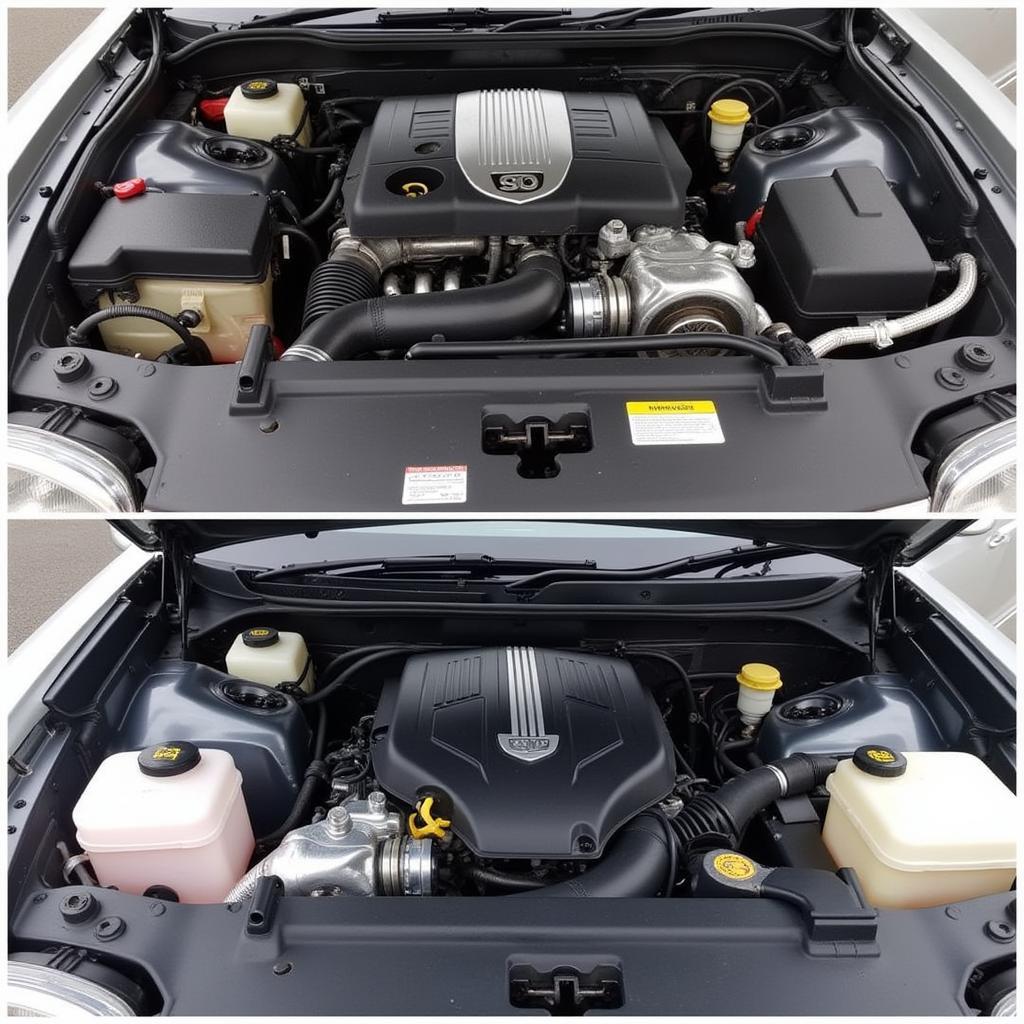Detailing a car engine not only enhances its appearance but also protects vital components and can even improve performance. Knowing how to properly detail your car engine is a valuable skill, whether you’re a car enthusiast or simply want to maintain your vehicle’s value. This guide will walk you through the entire process, from preparation to final touches.
Cleaning your car’s engine can seem daunting, but with the right approach and tools, it’s a manageable task. This comprehensive guide will provide you with a step-by-step process, along with essential tips and tricks for achieving professional-level results. By understanding the intricacies of engine detailing, you can keep your engine bay looking pristine and ensure optimal performance. Do you know how long doe sit take to detail a car? It can vary depending on the level of detail, but engine cleaning is a significant part of the process.
Preparing for the Engine Detail
Before you begin cleaning, it’s crucial to prepare the engine bay properly. This involves gathering the necessary supplies and taking precautions to protect sensitive components. First, gather your materials: engine degreaser, various brushes (detailing brushes, toothbrush, etc.), microfiber towels, plastic bags, masking tape, and a garden hose with a spray nozzle. Next, cover sensitive components like the alternator, distributor, and air intake with plastic bags and secure them with masking tape. This will prevent water and cleaning solutions from damaging these vital parts. Finally, allow the engine to cool down completely before starting the cleaning process. Working on a hot engine can be dangerous and can also damage certain components.
Degreasing and Cleaning the Engine
Once the engine bay is prepared, you can begin the degreasing process. Apply the engine degreaser liberally to all engine surfaces, following the manufacturer’s instructions. Allow the degreaser to dwell for the recommended time, typically a few minutes, to effectively break down grease and grime. Using a variety of brushes, agitate the degreaser, paying particular attention to hard-to-reach areas and crevices. For stubborn grime, a toothbrush or detailing brush can be particularly effective. Once you’ve thoroughly scrubbed the engine bay, rinse it thoroughly with a garden hose, using a gentle spray nozzle to avoid forcing water into sensitive areas.
Drying and Protecting the Engine
After rinsing, thoroughly dry the engine bay using microfiber towels. Ensure all surfaces are completely dry to prevent water spots and potential corrosion. You might want to consider using compressed air to blow out any remaining water from hard-to-reach areas. What i need for car detailing includes specific tools for drying the engine, like a high-quality air blower. Finally, apply an engine protectant to give the engine bay a showroom finish and protect against future grime buildup. This step also helps to enhance the appearance of hoses and plastic components.
Final Touches and Inspection
Once the engine is dry and protected, inspect the engine bay carefully to ensure everything is clean and in place. Remove the plastic bags and masking tape, and double-check that all components are functioning correctly. Take a step back and admire your sparkling clean engine bay! Knowing how to detail car includes this essential engine cleaning process.
“A clean engine bay not only looks fantastic but also makes it easier to spot potential leaks or issues,” says renowned automotive expert, David Miller, from the Institute of Automotive Excellence. “Regular engine cleaning is a crucial part of preventative maintenance.”
Frequently Asked Questions (FAQ)
- How often should I detail my car engine? Ideally, every 3-6 months, or more frequently if you drive in harsh conditions.
- Can I use a pressure washer to clean my engine? It’s generally not recommended, as the high pressure can damage sensitive components.
- What type of engine degreaser should I use? A dedicated engine degreaser is best, but a general-purpose degreaser can also work. Always follow the manufacturer’s instructions.
- Is it safe to clean the engine while it’s hot? No, it’s crucial to allow the engine to cool down completely before cleaning.
- What are the benefits of engine detailing? Improved appearance, easier maintenance, protection of components, and potential performance enhancement.
- Can I detail my engine myself, or should I hire a professional? Detailing your engine yourself is possible with the right tools and knowledge. However, if you’re unsure, hiring a car detailer is always a safe option.
- Is car detailing necessary? Many people ask is car detailing necessary? While not strictly necessary, it significantly improves the appearance and longevity of your vehicle.
Conclusion
Detailing a car engine is a rewarding process that significantly enhances the overall appearance and longevity of your vehicle. By following the steps outlined in this guide, you can achieve professional-level results and keep your engine bay looking pristine. Regular engine cleaning is a key aspect of car maintenance and helps to protect vital components. So, roll up your sleeves, gather your supplies, and give your car engine the attention it deserves!
 Sparkling Clean Car Engine Bay After Detailing
Sparkling Clean Car Engine Bay After Detailing
Some other situations you might encounter and have questions about are: Dealing with particularly stubborn grease and grime, Protecting electrical connections effectively, and Choosing the right engine protectant for your specific car.
You might also be interested in these other articles on our website: “How to Wash Your Car Like a Pro”, “The Ultimate Guide to Interior Car Detailing”, and “Choosing the Right Car Wax for Your Paint”.
Need help? Contact us via WhatsApp: +1(641)206-8880, or Email: [email protected]. Our customer support team is available 24/7.

Leave a Reply